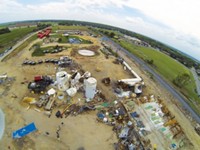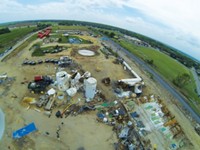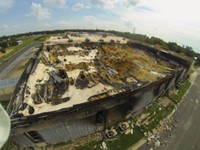Advertisement
Grab your lab coat. Let's get started
Welcome!
Welcome!
Create an account below to get 6 C&EN articles per month, receive newsletters and more - all free.
It seems this is your first time logging in online. Please enter the following information to continue.
As an ACS member you automatically get access to this site. All we need is few more details to create your reading experience.
Not you? Sign in with a different account.
Not you? Sign in with a different account.
ERROR 1
ERROR 1
ERROR 2
ERROR 2
ERROR 2
ERROR 2
ERROR 2
Password and Confirm password must match.
If you have an ACS member number, please enter it here so we can link this account to your membership. (optional)
ERROR 2
ACS values your privacy. By submitting your information, you are gaining access to C&EN and subscribing to our weekly newsletter. We use the information you provide to make your reading experience better, and we will never sell your data to third party members.
Safety
An Explosive Situation
by Josh Fischman
April 29, 2013
| A version of this story appeared in
Volume 91, Issue 17
To celebrate C&EN’s 90th anniversary, one Editor’s Page each month will examine materials from C&EN Archives. Featured articles are freely downloadable for one month.
The Texas town was nearly leveled by the blast from exploding ammonium nitrate. Nearly 600 people were killed, including 27 of the town’s 28 firefighters who had closed in on the blazing fertilizer. More than 500 homes were destroyed. Debris was hurled miles away. The shock wave shattered windows in nearby cities.
This disaster, now considered the worst industrial accident in U.S. history, happened 200 miles from and 66 years earlier than the April 17 ammonium nitrate explosion in West, Texas, that recently horrified the country even as we were reeling from the Boston Marathon bombings. The 1947 detonation occurred aboard a ship in Galveston Bay packed with fertilizer; the blast two weeks ago was at a small fertilizer distribution facility. At least 15 people were killed in West. Most of them were firefighters, rushing toward the blaze like those in 1947, unaware of the danger posed by the chemical inside. In the C&EN Archives, reading between these two points in time, a person can find many articles on ammonium nitrate’s explosive nature and other accidents that it caused. The multiple reports and incidents make one wonder how distributors of the substance—and state and federal agencies that are supposed to ensure health and safety—repeatedly turned a blind eye to the hazard.
In April 1947, the S.S. Grandcamp, the ship in Galveston Bay, was packed with 2,300 tons of the material. It was bound for France, ravaged and hungry after World War II. The fertilizer is valuable and effective, used on pastures and cropland. But a Sept. 15, 1947, article in C&EN described initial findings of a federal interagency task force investigating the calamity. The investigators found that ammonium nitrate, normally a stable compound, isn’t stable under high heat and pressure, such as in the crammed hold of a ship. (The chemical, once ignited, readily gives off oxygen, creating more fire and heat and pressure in a runaway reaction.) Evidently a sailor, smoking nearby, started a fire that wouldn’t go out. The captain tried to smother it by pumping in steam, and that only increased the pressure. The first smoke was spotted at about 8 AM. At 9:12, the ship erupted. Its 2-ton anchor was hurled more than 1.5 miles away.
On Oct. 20, 1947, C&EN reported that an expert at the President’s Conference on Fire Prevention said the disaster could have been prevented if “reasonable safety rules had been observed.”
Apparently that hasn’t happened. In 2001, C&EN reported that an ammonium nitrate explosion at a TotalFinaElf facility in France killed at least 29 people. And in West, Texas, it seems clear that state agencies that could regulate fertilizer storage either didn’t know about the 270 tons of ammonium nitrate stored there or believed it wasn’t their responsibility. According to the Dallas Morning News, the Texas Commission on Environmental Quality had paperwork noting the ammonium nitrate but says it focuses on things like air emissions, not storage safety.
Federal agencies are supposed to monitor fertilizer storage. The Department of Homeland Security became involved after the Oklahoma City federal building bombers used ammonium nitrate and fuel oil, C&EN reported in 2006. A 2008 amendment to the Homeland Security Act requires the department to “regulate the sale and transfer of ammonium nitrate by an ammonium nitrate facility ... to prevent the misappropriation or use of ammonium nitrate in an act of terrorism.” Just how to do this hasn’t yet been settled. And on page 5 of this issue, Glenn Hess and Jeff Johnson report that the Texas facility never filed any report with the department.
They also note the storage facility didn’t appear to separate the fertilizer from other substances or have fire prevention systems in place. Tragically, reports are that an associated fire preceded the explosion, like it did on the S.S. Grandcamp.
We haven’t acted on what we’ve learned since that ship blew up. And once again, firefighters and the town they were defending paid a terrible price.





Join the conversation
Contact the reporter
Submit a Letter to the Editor for publication
Engage with us on Twitter